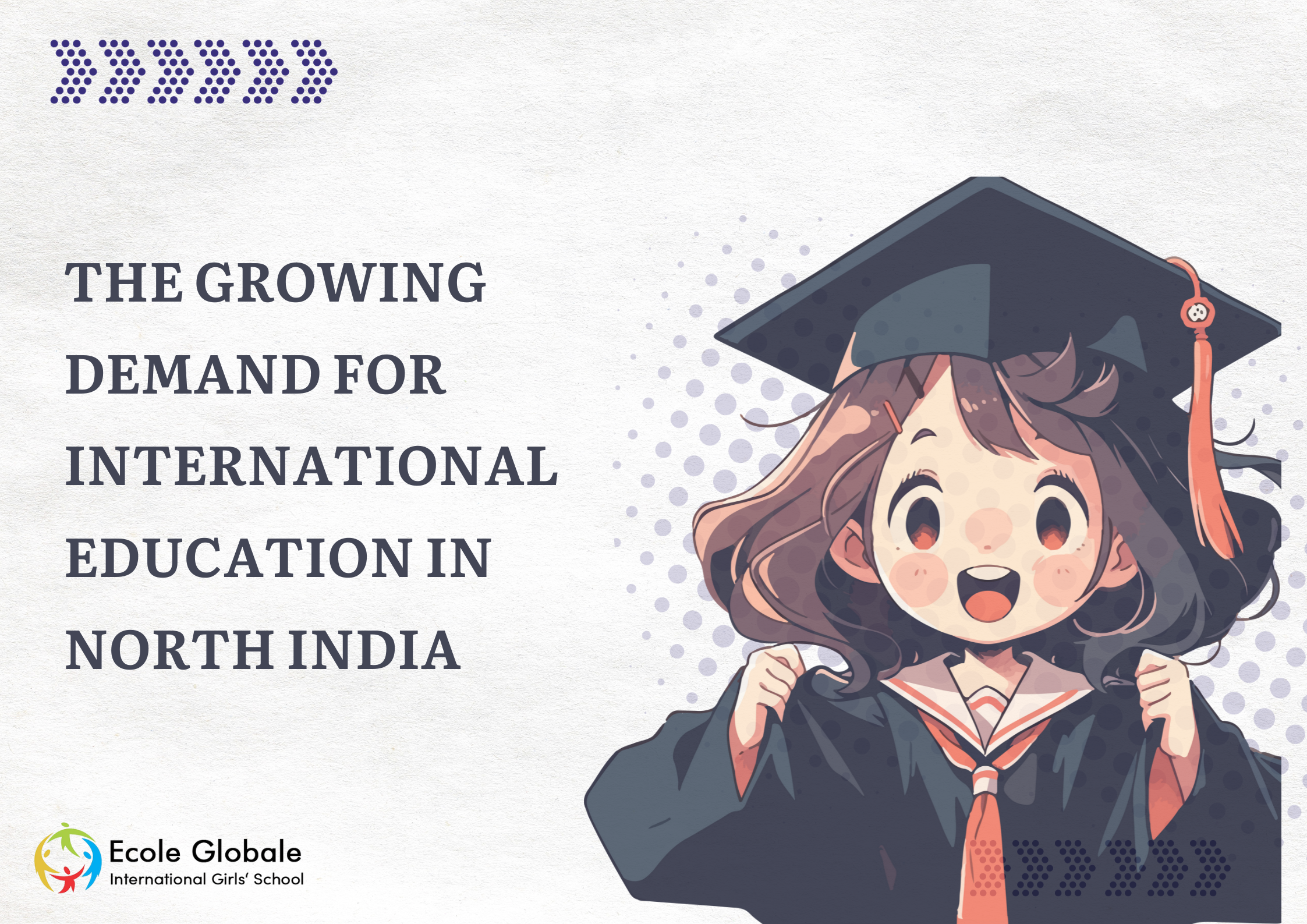The growing demand for international education in North India is a multifaceted phenomenon, reflecting broader trends in globalization, economic development, and a shifting workforce.
This in-depth exploration will delve into the various aspects of this surge in interest, its implications, and the challenges it presents, while providing a comprehensive overview of the evolving educational landscape in this region.
Globalization and Changing Perspectives for international education in North India

Global Exposure:
The pursuit of global exposure for children in North Indian families has become increasingly prominent. This shift in perspective is driven by a recognition of the importance of understanding and engaging with diverse cultures and global viewpoints.
International education in north india offers exposure to a variety of cultures, helping students develop a more rounded worldview, crucial in today’s interconnected global society.
Quality of Education:
The perceived quality and holistic nature of international curricula such as the International Baccalaureate (IB) and the International General Certificate of Secondary Education (IGCSE) are major draws.
These curricula are seen as more dynamic and comprehensive compared to traditional Indian educational models, focusing on critical thinking, creativity, and overall personality development.
Language Proficiency:
English language proficiency is increasingly seen as a key to unlocking global opportunities.
International schools, with their emphasis on English as a primary medium of instruction, offer a more immersive environment for mastering the language, which is often seen as a gateway to higher education and career opportunities worldwide.
Cultural Shift:
A significant cultural shift is occurring in North India, where education is increasingly valued not just as a pathway to a successful career but also as a means of personal development.
This broader view of education’s role is driving parents and students alike towards international educational systems, which are perceived to offer more in terms of personal growth and global readiness.
Economic Development and Aspirations

Increased Affluence:
The economic boom in North India, particularly among the middle and upper classes, has led to an increase in disposable income. This financial empowerment has enabled more families to consider international education, which is often more expensive than traditional options, as a viable choice for their children.
Career Opportunities:
There’s a growing awareness that an international education can provide a competitive edge in the global job market. Especially in fields like technology, finance, and management, employers often look for candidates with a global perspective and education.
Entrepreneurial Aspirations:
The burgeoning entrepreneurial ecosystem in North India places a high value on the diverse skill set, innovative thinking, and global networking opportunities provided by international education. Aspiring entrepreneurs, particularly in start-ups and tech industries, view an international education as a stepping stone to building global businesses.
Workforce and Industry Demands

Global Workforce:
The expansion of Indian companies on the global stage, coupled with the influx of multinational corporations in India, has created a demand for a workforce with an international mindset and education. Employees who are comfortable navigating global cultures and business practices are increasingly sought after.
Tech and Innovation:
In sectors like technology and innovation, there is a particular emphasis on international education. These fields are rapidly evolving, and the curriculum offered by international schools is often more aligned with current global trends and technological advancements.
Skill Gaps:
Traditional education systems are sometimes perceived as not keeping pace with the rapidly changing skill requirements of modern industries. This has led to a greater appeal for international education, which is seen as more adaptable and forward-thinking in its approach to skill development.
Challenges and Considerations
Accessibility and Inclusivity:
Despite the high demand, international education remains out of reach for many due to its high cost. This raises significant concerns about educational inequality and the creation of a socio-economic divide in access to quality education.
Cultural Dissonance:
There is a challenge in integrating international education within the Indian cultural context. Striking a balance between global perspectives and local values and traditions is crucial, as there is a risk of cultural dissonance where students may feel disconnected from their cultural roots.
Quality Assurance:
The rapid growth in the number of international schools has raised concerns about maintaining high educational standards. Ensuring that these schools adhere to their international curricula and provide a genuinely global education is critical.
Regulatory Framework:
The regulatory environment for education in India can be complex and sometimes challenging to navigate. Clear and supportive policies are needed to ensure that international schools can operate effectively and contribute positively to the educational landscape.
Implications for the Future
Educational Reform:
The increasing demand for international education may act as a catalyst for broader reforms in the traditional Indian education system. This could lead to the adoption of more holistic, flexible, and globally oriented approaches in mainstream education.
Economic Impact:
This trend has the potential to significantly impact the economy, not only through the direct creation of jobs in the education sector but also by contributing to the development of a more skilled and globally-oriented workforce.
Cultural Integration:
The growing prevalence of international education could lead to greater cultural integration and understanding within North Indian society. This could foster a more globally connected and culturally aware generation.
Technology Integration:
The role of technology in education, a key component of many international curricula, is likely to expand further. This could lead to a transformative effect on the educational landscape, with digital learning becoming more prominent.
Conclusion
The surge in demand for international education in North India represents a complex shift influenced by a variety of global, economic, and cultural factors. While offering opportunities for personal and professional growth, it also presents challenges related to accessibility, cultural integration, and maintaining educational quality.
The ongoing evolution of this trend will likely have far-reaching implications for the educational landscape, the workforce, and the broader society in North India. This dynamic interplay of factors underscores the need for thoughtful engagement with the concept of international education in North india and its role in shaping future generations.
Q1: What are the primary reasons behind the growing popularity of international education in North India?
Answer: The popularity of international education in North India is driven by several factors.
Firstly, globalization has increased the exposure of North Indian families to different cultures and educational systems, making international education in North India more appealing.
Secondly, there’s a growing perception that international curricula, like IB and IGCSE, offer a more holistic and comprehensive educational experience compared to traditional Indian curricula, focusing not just on academic excellence but also on developing critical thinking and creative skills.
Thirdly, English language proficiency, which is emphasized in international schools, is seen as crucial for global career opportunities.
Lastly, the economic growth in North India has resulted in increased disposable income among middle-class families, making international education in North financially accessible to a larger segment of the population.
Q2: How does international education in North India contribute to career opportunities for students?
Answer: International education in North India equips students with a global perspective and skills that are highly valued in the modern workforce.
This form of education often includes critical thinking, problem-solving, and adaptability, which are essential in today’s fast-paced and ever-changing job market. Graduates from international programs are often seen as more attractive to multinational corporations and industries that operate on a global scale.
Additionally, the proficiency in English and other foreign languages gained through international education in North India opens up opportunities for higher education and employment in different parts of the world.
Q3: Are there any cultural challenges associated with the adoption of international education in North India?
Answer: Yes, there are cultural challenges. One of the main issues is balancing the global perspective offered by international education in North india with the local values and traditions of Indian culture.
There’s a risk that students may feel disconnected from their cultural roots, leading to a sense of dissonance. Families and educators must work to ensure that while students are exposed to global ideas and practices, they also retain a strong connection to and understanding of their own culture and heritage.
Q4: What impact does the trend towards international education in North India have on the traditional Indian education system?
Answer: The trend towards international education in North India is pushing the traditional Indian education system to evolve. There’s a growing realization that the Indian system needs to incorporate more holistic, flexible, and globally-oriented approaches to education.
This can lead to reforms that emphasize not just rote learning and examination success but also the development of soft skills, critical thinking, and a broader world view. Such changes could make the Indian education system more dynamic and relevant in the 21st century.
Q5: How does international education address the skill gaps in modern industries?
Answer: International education in North india is often more aligned with the current trends and practices in modern industries, particularly in sectors like technology, innovation, and entrepreneurship.
It tends to focus on skill development in areas like digital literacy, innovation, and creative problem-solving, which are increasingly important in the modern workforce. This education system also promotes adaptability and lifelong learning, skills that are essential in an era where professional and technological landscapes are constantly evolving.
Q6: What are the long-term implications of this trend for North Indian society?
Answer: In the long term, the trend towards international education in North India could lead to the development of a more globally integrated society.
It can foster greater cultural understanding and cooperation, as well as contribute to the creation of a workforce that is skilled, versatile, and capable of navigating global challenges.
Economically, this trend could stimulate growth in the education sector and beyond, leading to job creation and investment opportunities.
However, it also raises important questions about educational equity and the need to ensure that the benefits of international education in North India are accessible to a broader segment of the population.











